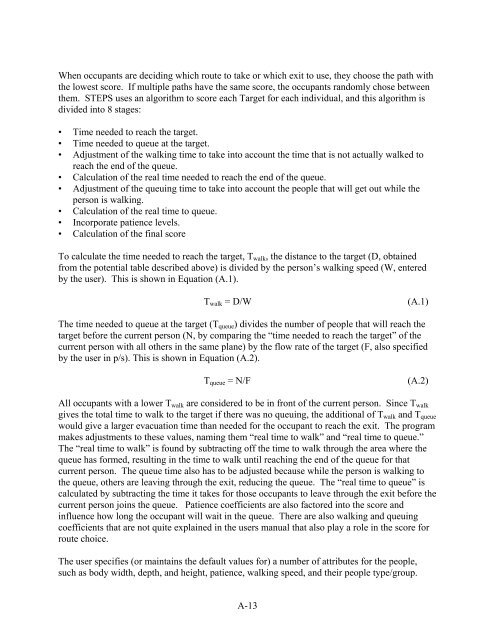A Review of Building Evacuation Models - NIST Virtual Library
A Review of Building Evacuation Models - NIST Virtual Library
A Review of Building Evacuation Models - NIST Virtual Library
Create successful ePaper yourself
Turn your PDF publications into a flip-book with our unique Google optimized e-Paper software.
When occupants are deciding which route to take or which exit to use, they choose the path with<br />
the lowest score. If multiple paths have the same score, the occupants randomly chose between<br />
them. STEPS uses an algorithm to score each Target for each individual, and this algorithm is<br />
divided into 8 stages:<br />
• Time needed to reach the target.<br />
• Time needed to queue at the target.<br />
• Adjustment <strong>of</strong> the walking time to take into account the time that is not actually walked to<br />
reach the end <strong>of</strong> the queue.<br />
• Calculation <strong>of</strong> the real time needed to reach the end <strong>of</strong> the queue.<br />
• Adjustment <strong>of</strong> the queuing time to take into account the people that will get out while the<br />
person is walking.<br />
• Calculation <strong>of</strong> the real time to queue.<br />
• Incorporate patience levels.<br />
• Calculation <strong>of</strong> the final score<br />
To calculate the time needed to reach the target, T walk , the distance to the target (D, obtained<br />
from the potential table described above) is divided by the person’s walking speed (W, entered<br />
by the user). This is shown in Equation (A.1).<br />
T walk = D/W<br />
(A.1)<br />
The time needed to queue at the target (T queue ) divides the number <strong>of</strong> people that will reach the<br />
target before the current person (N, by comparing the “time needed to reach the target” <strong>of</strong> the<br />
current person with all others in the same plane) by the flow rate <strong>of</strong> the target (F, also specified<br />
by the user in p/s). This is shown in Equation (A.2).<br />
T queue = N/F<br />
(A.2)<br />
All occupants with a lower T walk are considered to be in front <strong>of</strong> the current person. Since T walk<br />
gives the total time to walk to the target if there was no queuing, the additional <strong>of</strong> T walk and T queue<br />
would give a larger evacuation time than needed for the occupant to reach the exit. The program<br />
makes adjustments to these values, naming them “real time to walk” and “real time to queue.”<br />
The “real time to walk” is found by subtracting <strong>of</strong>f the time to walk through the area where the<br />
queue has formed, resulting in the time to walk until reaching the end <strong>of</strong> the queue for that<br />
current person. The queue time also has to be adjusted because while the person is walking to<br />
the queue, others are leaving through the exit, reducing the queue. The “real time to queue” is<br />
calculated by subtracting the time it takes for those occupants to leave through the exit before the<br />
current person joins the queue. Patience coefficients are also factored into the score and<br />
influence how long the occupant will wait in the queue. There are also walking and queuing<br />
coefficients that are not quite explained in the users manual that also play a role in the score for<br />
route choice.<br />
The user specifies (or maintains the default values for) a number <strong>of</strong> attributes for the people,<br />
such as body width, depth, and height, patience, walking speed, and their people type/group.<br />
A-13
















